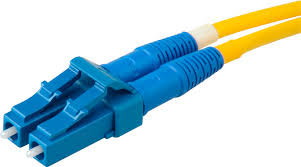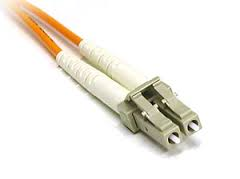Fibre-types
SX uses multimode (grey connector jacks)
LX typically uses singlemode (blue connector jacks) for <5km , or multimode (grey connector jacks) <550m
There are two basic fibre families
Singlemode (Blue connector jacks ) (SM, OS1.OS2)

Sheath options are generally indoor PVC or LSZH and external Nylon with CST or GRP armouring
Singlemode is fairly straightforward its the smallest of the traditional fibres and is made of 9 micron glass core. Singlemode transmits light via a single ray of light. It often but not always has a yellow outer jacket (pvc or lszh) and can be used for links up to 100km.
Multimode (Grey connector jacks) (MM defines four types OM1, OM2, OM3 and OM4)

transmits many rays (modes) of light simultaneously and has 4 types and is made with larger cores of 62.5 and 50 micron.
OM1 (optical mode 1) is the original of the species and rarely used today. It has the largest core size of 62.5 micron and although suitable for 100Mb and 1Gb it has serious limitations for todays high speed demands typically orange in colour. Certainly not recommended for new installations as it has no benefits over 50 micron fibres.
OM2 It has a core size of 50 microns and again was introduced in the 1980's with 1Gb technology was future proofing but it is now no longer relevant with the developement of "laser optimised" multimode fibres. Again not recommended for new installations.
OM3 is the most widely used multimode fibre today it also has a 50 micron glass core which is laser optimised. It is designed to cope with 40Gb applications up to 100mtrs and is identified by its distinctive aqua colour.
OM4 is the newest of these. It has a lower insertion loss and an EMB of 4700. It also has a laser optimised 50 micron glass core it is the preferred technology for the emerging standards that will operate at 40Gb and even 100Gb up to 150mtrs and is widely used in Datacentre applications but with little cost difference over OM3 its likely to be default choice.
| 62.5/125 OM1 | 50/125 OM2 | 50/125 OM3 | 50/125 OM4 | 9/125 OS1 | |
|---|---|---|---|---|---|
| 100Mb | 2km | 2km | 2km | 2km | 100km |
| 1Gb | 275mtr | 550mtr | 800mtr | 1100mtr | 100km |
| 10Gb | 33mtr | 82mtr | 300mtr | 550mtr | 40km |
| 40Gb/100Gb | N/A | N/A | 100mtr | 150mtr | 40km |
From examining the above table it gives us some important clues as to deciding the best option. For instance your client wants a link between 2 buildings thats approx 200 mtrs long and he wants to make sure its future proof in this case we would recommend an OM3 fibre wheras if the link was 500mtrs we would elect for an OM4 needless to say anything beyond 550mtrs we would opt for Singlemode. These selections will guarantee 10Gb transmissions speeds and higher to cater for future requirements.

